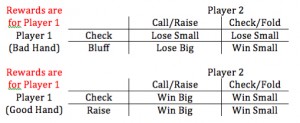Poker and Game Theory
Game theory lends itself well to many scenarios in life, but there will always be one place where it can be best utilized- in a game. Texas Hold ‘Em is one such game, where game theory can greatly influence players’ decisions. Many observers claim that one player, Chris Ferguson, revolutionized the game by heavily utilizing game theory with a method called “optimal strategy,” which involves thinking “how do I lose the least?” He has won millions playing poker and was a big part of developing the software for FullTiltPoker.com, a site where players can gamble for real money. Ferguson brought advance game theory to the game, but even simple game theory is used constantly.
Basic game theory in poker is very intuitive if you know the rules of poker when the game is broken down into simple cases. One example is when you know you have a winning hand. In poker, the best hand at any given moment is called “the nuts.” When you have the nuts, a strong hand, or even a strong suspicion that your opponent has a weaker hand, a strategy comes into play. You have two distinct options, to check or to raise. Your goal is to get your opponent to put is as much money as possible. The more obvious option is to raise- to make your opponent put more money in the pot to stay in. The upside is that if he calls, you have won more money. The downside though, is that a raise is a sign of strength, so this could make your opponent fold, leaving you with minimal winnings. He will only call if he still thinks he can beat you, either because he has a descent hand or because he thinks you’re bluffing. Your other option is to check. This too has its dangers. If you check, and your opponent also checks, you have won, but only what is already in the pot. If you check, your hope is that your opponent senses weakness, and again, either because he has a descent hand or because he thinks you have nothing, he will raise you. If so, you have just gained more money. Poker pros like Ferguson decide how to bet based on how their opponent has acted in the past and how they can win more money in the long run, even if sacrificing a small gain.
Another example is when you have a bad hand. Sometimes you know you’re holding a loser, but you think you might have a chance to make your opponent fold by bluffing. As when you have a good hand, you have two options, to check or to raise. This time though, checking is admitting defeat. By checking, no matter what your opponent does, check or raise, he will beat you because his hand is better. This seems bad, but the alternative is much riskier. If you raise, you are essentially putting your money behind a losing hand. Either he (rightfully) thinks he can beat you and calls, and you lose a lot of money, or he is scared and folds, in which case you win a very small amount of money. Examining this scenario, at first glance it seems like never bluffing is the best way to go, because you never open your self up to big loss, but in reality this can be a bad decision. If you only play good hands, your opponents will catch on and take your money by folding whenever you raise and raising whenever you don’t.
Professionals have strategies about how much to bluff which resemble mixed strategies. They’ll note how much their bluffs are being called and adjust how much they bluff to come out even. For example, if they are getting called 25% of the time, they would bet a third of the pot, so that the three times they win make up for the one time they don’t. The best poker player know every strategy and adjust their game on the fly to match their opponents. Game theory has become viable in many strategies and is now basic knowledge for any poker player.
http://www.newyorker.com/reporting/2009/03/30/090330fa_fact_wilkinson
http://www.sitandgoplanet.com/multitable/mtt_strategy/Poker_Game_Theory.html
-MrPieGuy

